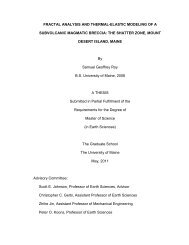Exploring the Methods of Differential Calculus through the ...
Exploring the Methods of Differential Calculus through the ...
Exploring the Methods of Differential Calculus through the ...
You also want an ePaper? Increase the reach of your titles
YUMPU automatically turns print PDFs into web optimized ePapers that Google loves.
Figure 5. Graphs <strong>of</strong> <strong>the</strong> three candidate ramps.<br />
In Figure 5 (and all o<strong>the</strong>r figures in this section), distance stands for <strong>the</strong> horizontal distance, not<br />
<strong>the</strong> distance along <strong>the</strong> ramp. This graph represents <strong>the</strong> three candidate ramps. The bottom line is<br />
<strong>the</strong> first candidate; <strong>the</strong> middle line is <strong>the</strong> second candidate, and <strong>the</strong> top line is <strong>the</strong> third candidate.<br />
All three candidates ramps start and end at <strong>the</strong> same point but don’t have any o<strong>the</strong>r common<br />
points. Candidate one starts <strong>of</strong>f with a steep decline and <strong>the</strong>n flattens out. Candidate two has a<br />
steady decline from point A to point B. Candidate three starts <strong>of</strong>f with a slowly declining and<br />
<strong>the</strong>n ends with a steep decline.<br />
The next step is to take <strong>the</strong> first derivative <strong>of</strong> each candidate ramp. The first derivative will be<br />
<strong>the</strong> velocity attained by <strong>the</strong> bead at that point on <strong>the</strong> ramp. A graph <strong>of</strong> <strong>the</strong> velocity curves is<br />
presented in Figure 6.<br />
Candidate Ramp One:<br />
Candidate Ramp Two:<br />
Candidate Ramp Three:
















